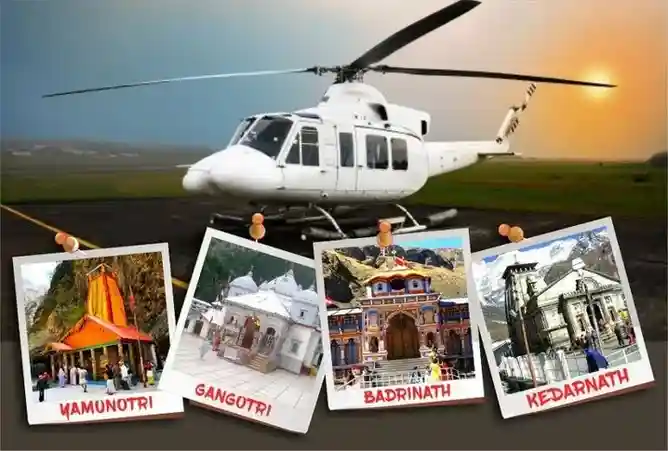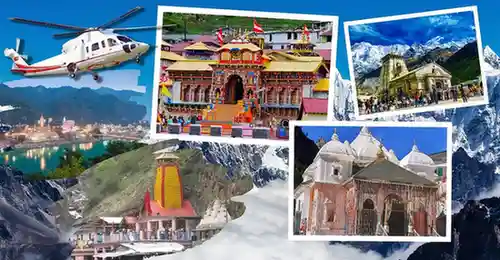Char Dham Tour: Char Dham Yatra is unparalleled in its value in the hearts of a million Hindus in India and the world at large. Taking a journey to the four holy shrines in Uttarakhand—Yamunotri, Gangotri, Kedarnath, and Badrinath—is not just a pilgrimage to get blessings from God but also a spiritual experience that touches one’s soul. When you undertake this pilgrimage with the attitude of “Sharanagatam” (completely surrendering to the divine will and seeking protection in the almighty), planning turns out to be an integrative process that incorporates both pragmatic logistics and profound spiritual preparation.
Table of Contents
Understanding the Spiritual Essence: The Meaning of Sharanagatam

The Sanskrit word “Sharanagatam” means the process of surrendering ego and taking shelter in God. It is a notion heavily embedded in the spirit of Char Dham Yatra. When one takes the attitude of absolute surrender, he not only purifies the soul but also spiritually and mentally readies himself for the journey that lies ahead. The difficulties—steep mountain roads, changing weather, or challenging treks—can then be regarded as part of a higher plan that eventually culminates in spiritual growth.
Remember, the path is as important as the destination. Embracing sharanagatam means to have faith in the process, be tolerant of the capricious nature of the Himalayas, and let every moment change you.
Why the Char Dham Yatra?

Before you dive into the logistics, it’s helpful to know why millions are attracted to this pilgrimage annually:
- Spiritual Renewal: Pilgrims believe that finishing the Char Dham Yatra erases sins and sets the stage for moksha (release from the cycle of birth and death).
- Connect with Nature: Located in the majestic Garhwal Himalayas, the trail presents breathtaking scenery, untouched landscapes, and an opportunity to be in touch with nature at its holiest.
- Cultural Experience: The yatra is intertwined with local traditions, ancient customs, and historic legends that make your experience of Hindu spirituality and culture richer.
- Personal Transformation: At every step of the way—from the peaceful meditation at Yamunotri to the grueling trek to Kedarnath—there is a chance for self-reflection and inner development.
By keeping these spiritual advantages in mind, you can make every planning decision with purpose and clarity.
Step-by-Step Guide to Planning Your Char Dham Tour
Organizing your Char Dham trip has multiple layers of logistics, each as significant as the next. Here, we detail the essential steps you must take:
1. Research and Pre-Planning
Understanding the Route
- Yamunotri: The beginning of the yatra. Situated at an elevation of about 3,293 meters, it is the source of the Yamuna River and is accessible only by a short trek from Janki Chatti.
- Gangotri: Devoted to Goddess Ganga and lying at an altitude of about 3,034 meters, Gangotri is open by road with a little extra trekking for those who want to go to Gaumukh (the source of the glacier).
- Kedarnath: A sparsely inhabited and spiritually intense location, Kedarnath is located at 3,580 meters. One needs to trek about 16 km from Gaurikund (or take a helicopter ride) and it is famous for its austere beauty.
- Badrinath: The last dwelling, which is devoted to Lord Vishnu, is at 3,415 meters and has comparatively easier access by road.
Knowing these routes will enable you to customize your itinerary according to your physical comfort and spiritual desires.
Learning the History and Rituals
Get to know the ancient myths, temple hours, and customs of each location. This makes you value the importance of each ritual and enables you to join in with a greater sense of respect.
Setting a Budget
Set a realistic budget for:
- Transport: Inter-city travel costs, local taxi fares, bus or self-drive hire, and possibly helicopter transfers.
- Accommodation: Budget stay versus luxury stay in important towns such as Barkot, Uttarkashi, Guptkashi, and Badrinath.
- Food and Miscellaneous: Food, permits, trekking equipment, and contingency funds.
2. Registration and Documentation
After you arrive, obtaining the necessary permits and completing registration procedures is important. This is what you need to do:
Online Registration
Official Portal: Go to the official Char Dham Yatra registration portal of the Uttarakhand government. Registration usually begins in late April or early May and is compulsory for all pilgrims.
Documents Required:
- Valid Photo ID (Aadhaar, Passport, or Driving License)
- Passport-sized photos
- Registration fees (usually a fixed percentage in advance)
- In certain cases, particularly in recent years, health documents (vaccination certificates or negative RT-PCR reports) may be needed
Offline Registration
If you want a guided package tour, most travel agencies provide total assistance with registrations. Make sure that your travel agency is approved and well-reputed.
Tip: Carry several copies of your registration documents with you, and save digital copies on your phone or cloud service as a backup.
3. Transportation Logistics
Transport is perhaps the most trying part of planning the Char Dham yatra. The Himalayan roads can be winding, long, and at times, unpredictable. Here are your choices:
By Road
- Private Taxi/Car: Hiring a private taxi or renting a car is flexible. See that the car is suitable for hilly routes. Some companies offer experienced drivers who know mountain roads.
- Public Bus Transport: A few government and private buses link important cities (Delhi, Haridwar, Rishikesh) with the starting points of the route such as Barkot. Cost-effective, though bus travel could be less convenient than a personal vehicle.
- Self-Drive: If you’re self-assured and familiar with driving in the mountains, then a self-drive option could appeal. Ensure that you’re aware of local road conditions and take necessary safety measures.
Trekking and Local Mobility
- Trekking: Trekking is required for Yamunotri and Kedarnath. Those who are not fond of walking long distances have local alternatives like pony rides, palanquins, or even porter services.
- Helicopter Services: The government runs regular helicopter services in Kedarnath, in particular. These not only spare one the effort but also time. Early booking is essential as the slots get filled up in no time.
Tip: Always check weather forecasts and road conditions as roadblocks or landslides are not rare in the hilly areas.
4. Accommodation and Food
You will be staying in different towns along the route during the yatra. These are some things to consider:
Accommodation Types
- Budget Hotels and Dharmshalas: Economical and culturally true facilities mostly managed by government agencies. They do not have many amenities but provide an opportunity to socialize with other pilgrims.
- Luxury Resorts: Comfort-seekers have the option of upscale hotels in towns such as Rishikesh or even close to Badrinath. These need to be reserved in advance, however.
- Guesthouses: Guesthouses in local areas offer a cozy, community feel. They’re a great way to witness local lifestyles.
Tip: Check the latest reviews and reserve your accommodation one to two months in advance, particularly if you intend to visit during the peak season (May–June, September–October).
Food and Refreshments
- Local Food: All the halts have authentic vegetarian food, which is wholesome and light, perfect for travelling at high altitude.
- Places to Eat: For dhabas and restaurants within the town/city, prefer those that take care of cleanliness and use fresh food. The temples also offer community kitchens or langars where you can sit and eat.
- Pack Food: Pack nuts, dried fruits, and energy bars as snack foods, especially for the days when you’re trekking since food may be scarce there.
Tip: Make sure that you keep drinking water during your journey and stick to bottled water or properly cleaned water.
5. Gear and Packing Essentials for Char Dham Tour
Packing efficiently can make a lot of difference to your safety and comfort while undertaking the yatra. Make a checklist including:
Clothing for char dham tour
Layered Clothing: Weather in the Himalayas can shift quickly. Carry clothing that can be layered, including:
- Breathable T-shirts and thermal innerwear
- Woollen jackets and sweaters for chilly nights
- Waterproof and windproof outerwear
- Modest Clothing: Temples demand modest clothing. Carry some decent, respectful dresses like long skirts, pants, or shoulder-covering dresses.
Footwear For Char Dham Tour
- Trekking Shoes: Buy good quality, non-slip trekking shoes.
- Sandals/Slippers: Convenient for short walks or hotel relaxation.
Accessories and Essentials Char Dham Tour
- Backpack: A comfortable, durable backpack to hold daily amenities.
- Trekking Poles: Convenient on steep or rough terrain.
- Sunscreen and Sunglasses: Sun protection against the strong mountain sun.
- Rain Gear: A small umbrella or raincoat.
- Personal Hygiene Items: Toilet basics and hand sanitizers.
- Medication and First Aid: Personal meds, a mini first aid kit, and any prescribed altitude sickness treatments.
- Documents & Cash: Make copies of your registration, identification, permits, and sufficient cash (since ATMs can be few and far between in rural areas).
Tip: Travel as lightly as you can while taking care to include all essentials. It may not be easy managing heavy luggage over long walks.
6. Precautions Related to Health and Safety
Your physical health remains top priority while crossing high terrain and tough trails. Keep in mind the following:
Physical Fitness
- Pre-Voyage Workout: Regular walks, cardiovascular, and yoga practices should be undergone at least 6–8 weeks prior to the trip in order to generate endurance.
- Acclimatization: Acclimatize yourself to higher altitudes by resting properly and taking an extra day or two at lower elevations.
Medical Preparations
- Consult Your Doctor: Make sure you have a medical check-up prior to your trip, especially if you have any chronic illnesses.
- Carry a Medical Kit: Pack items like painkillers, antiseptics, bandages, altitude sickness pills, and any prescribed medication.
- Emergency Contacts: Program emergency contacts into your telephone and inform relatives or friends of your itinerary.
Safety Procedures on the Trail
- Safe Transport: Always pick reputable and established taxi services or tour packages.
- Weather Notifications: Regularly monitor local weather forecasts to preclude travel postponements because of landslides or road blockages.
- Local Advice: Use local guides when trekking. Their knowledge and experience could prove invaluable during an emergency situation.
Tip: Positive thinking. Many times, a mere faith in the divinity of the journey and divine protection (sharanagatam) can guide you through tests with tranquility and forbearance.
7. Hassle-Free Tips
Following are some last pieces of advice to make your Char Dham Tour a hassle-free one:
Be Flexible
However hard you plan, unpredictable changes (weather disruptions, road work, or abrupt changes in temple hours) do happen. Remain flexible and ready to change your plans.
Maintain a Diary
Record your experience—be it the scenic vistas or spiritual moments of contemplation.
This not only serves as a memory aid but also gives insights for fellow pilgrims in the future.
Welcome the Experience
The Char Dham yatra is not merely a physical pilgrimage; it’s a spiritual journey. Take each moment as a learning experience in Sharanagatam. Whether it’s a tough trek or a peaceful moment at a temple, each experience is a chance to learn and grow as an individual.
Use Technology Wisely
Smartphones are useful for navigation, weather forecasts, and keeping in contact with loved ones. But do not let them divert your attention from the sacred experience. Equilibrate digital connection with thoughtful presence.
Cultural Sensitivity
Be sensitive to local culture and customs. Small gestures—such as dressing modestly, removing shoes at temple entrances, and maintaining silence during prayer—can enhance your experience and get you warm welcomes from locals.
Plan for Downtime
Long journeys can be exhausting. Include rest days or shorter itinerary segments to relax, meditate, or simply soak in the natural beauty surrounding you.
Join a Group Tour (If Comfortable)
For the first-time pilgrim, participating in a group tour is one way to eliminate much of the logistical worry. It has the convenience of shared experience, expert advice, and a set itinerary that is tested for safety and ease of travel. Yet, if you are going on your own and desire a more intimate experience, make sure that you’re properly prepared and properly informed.
Building Your Dream Itinerary
While a typical itinerary might provide a formal plan, it is important to adjust it according to your pace and interests. Below is an example itinerary for about 11 days, which you can adjust according to your interest:
Day 1: Arrival at Haridwar
- Arrive by train/flight.
- See Har Ki Pauri for the Ganga Aarti.
- Optional visit to local temples.
- Overnight stay at Haridwar or transfer to Rishikesh.
Day 2: Haridwar/Rishikesh to Barkot
- Start your drive early.
- Stop for short sightseeing along the way.
- Arrive in Barkot by evening.
- Overnight stay at Barkot.
Day 3: Barkot to Yamunotri and Back
- Drive to Janki Chatti; start the 4 km trek to Yamunotri.
- Finish darshan at Yamunotri, visit Surya Kund.
- Trek back to Janki Chatti and drive back to Barkot.
- Overnight stay at Barkot.
Day 4: Barkot to Uttarkashi
- Leave early in the morning for Uttarkashi.
- Enjoy Himalayan views along the way.
- Check in and rest upon arrival.
- Visit nearby temples if time allows.
- Overnight at Uttarkashi.
Day 5: Gangotri from Uttarkashi and back
- Early start to Gangotri.
- Have darshan at Gangotri Temple and optional village trek.
- Back in Uttarkashi by evening.
- Overnight in Uttarkashi.
Day 6: Guptkashi from Uttarkashi
- Leave for Guptkashi (or Sitapur), the starting point of Kedarnath.
- Scenic drive for many hours with halts in between.
- Arrival at Guptkashi, check in at the hotel, relax.
- Overnight in Guptkashi.
Day 7: Kedarnath Darshan
- Early drive to Gaurikund.
- Option to trek (or pony/palki) or helicopter ride to Kedarnath.
- Take part in darshan and rituals.
- Return to Guptkashi by late evening.
- Overnight stay in Guptkashi.
Day 8: Guptkashi to Badrinath
- Early start, drive through Joshimath.
- Arrive at Badrinath by afternoon.
- Visit the Badrinath Temple and other attractions like Tapt Kund.
- Overnight stay in Badrinath.
Day 9: Badrinath Exploration
- Option to visit Mana Village or Vyas Gufa.
- Explore further Badrinath’s spiritual delights.
- Take time to meditate and soak in the peaceful surroundings.
- Overnight in Badrinath.
Day 10: Badrinath to Rudraprayag/Rishikesh
- Begin the journey back, making a stop in Rudraprayag if desired.
- Arrive in Rishikesh or Haridwar by evening.
- Overnight stay.
Day 11: Departure
- Use this final day to relax, perhaps revisit a favorite spot, or shop for souvenirs.
- Transfer to the airport/railway station in Haridwar/Rishikesh/Delhi for your journey home.
Remember, this itinerary is a starting point. Adapt it according to your comfort level, travel style, and the prevailing circumstances during your travel dates.
Final Thoughts
Organizing a hassle-free Char Dham trip involves far more than reserving flights and hotels—it is an intimate fusion of physical arrangements with mental and spiritual preparation. Adopting the philosophy of sharanagatam reminds you to let go of the process and have faith that each twist and turn is part of a larger, divine plan.
Whichever way you choose to go – alone, with a group, or even take the faster helicopter-supported option – make sure that your heart is ready to embark not only on the physical trip, but also on the spiritual journey of letting go and evolution. As you drive along the serpentine roads from Haridwar to Badrinath through Yamunotri, Gangotri, and Kedarnath, each step will be an invitation to release worldly concerns and immerse in the eternal energy of devotion.
May your Char Dham Tour 2025 be filled with moments of inspiration, heartfelt prayers, and the kind of peace that only the Himalayas can provide. Remember, the essence of a hassle-free pilgrimage is balancing the practical with the spiritual—preparation, flexibility, and an open heart are your best friends on this holy journey.
Safe journey, and may the grace of Yamuna, Ganga, Shiva, and Vishnu be with you on your journey to inner realization.
Frequently Asked Questions
When is the best time to undertake a hassle‐free Char Dham tour?
The ideal time is from late April to early June or from September to October. These months offer stable weather and open routes.
How many days should I allocate for the Char Dham Tour?
Most pilgrims find that 10 to 12 days are sufficient for a comfortable journey. A shorter trip of 6 to 8 days is possible but might feel rushed.
What is the primary route of the Char Dham 2025 circuit?
The circuit begins at Yamunotri, then goes to Gangotri, followed by Kedarnath and ends at Badrinath. This is the traditional clockwise sequence.
Do I need to register for the CharDham Yatra? What documents are required?
Yes, registration is mandatory through the official portal or a trusted travel agency. You need a valid photo ID, two recent passport photographs, the completed form, and the registration fee.
What modes of transportation are available during the Chardham yatra?
You can travel by road using a private taxi or government buses. Some parts require trekking, and pony or palanquin rides are available. Helicopter services are also offered for segments like Kedarnath.
Can I use my own vehicle for the CharDham Yatra journey?
Yes, you can drive your own car until the road ends near Yamunotri and Kedarnath. You will have to switch to trekking or other local transport for the final parts.
What types of accommodation are available along the route?
There are budget hotels, dharmshalas, local guesthouses, and a few luxury options available at Chardham Yatra. Advanced booking is recommended during peak season.

